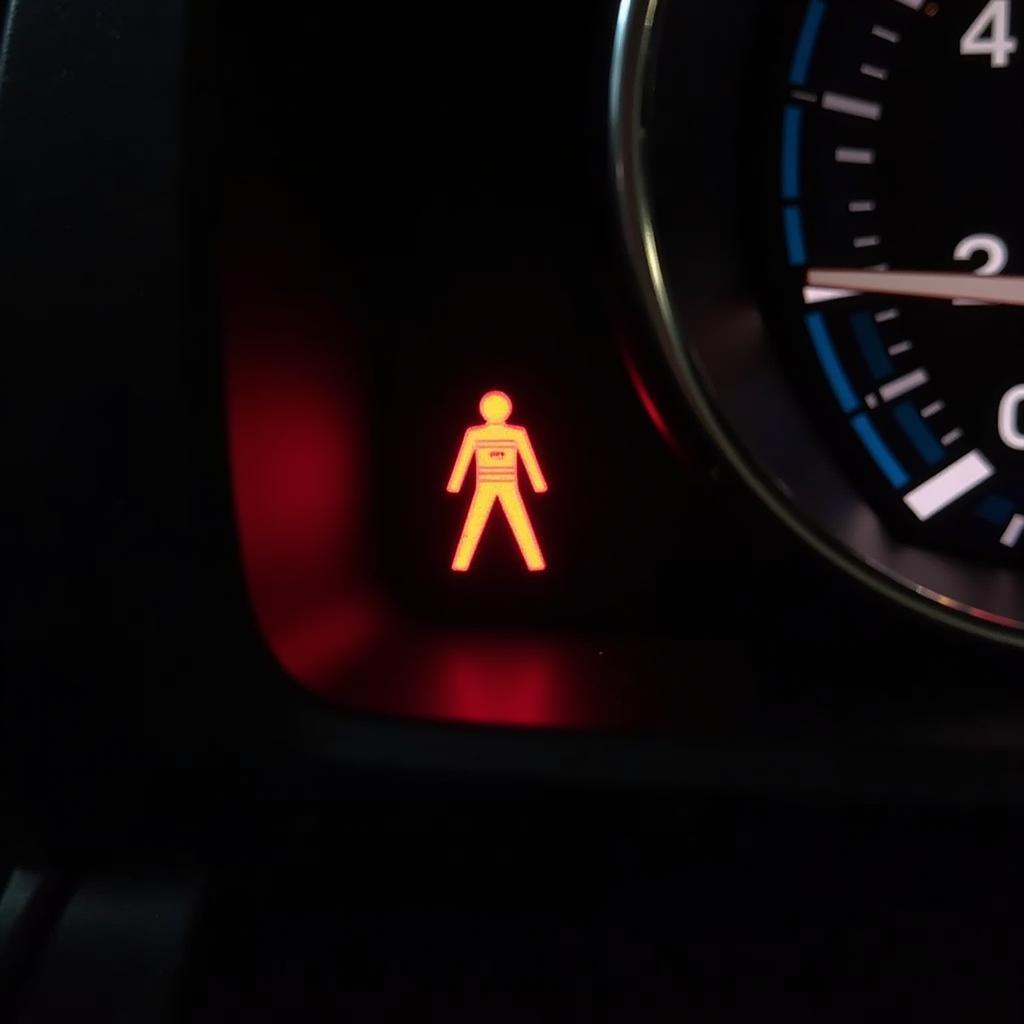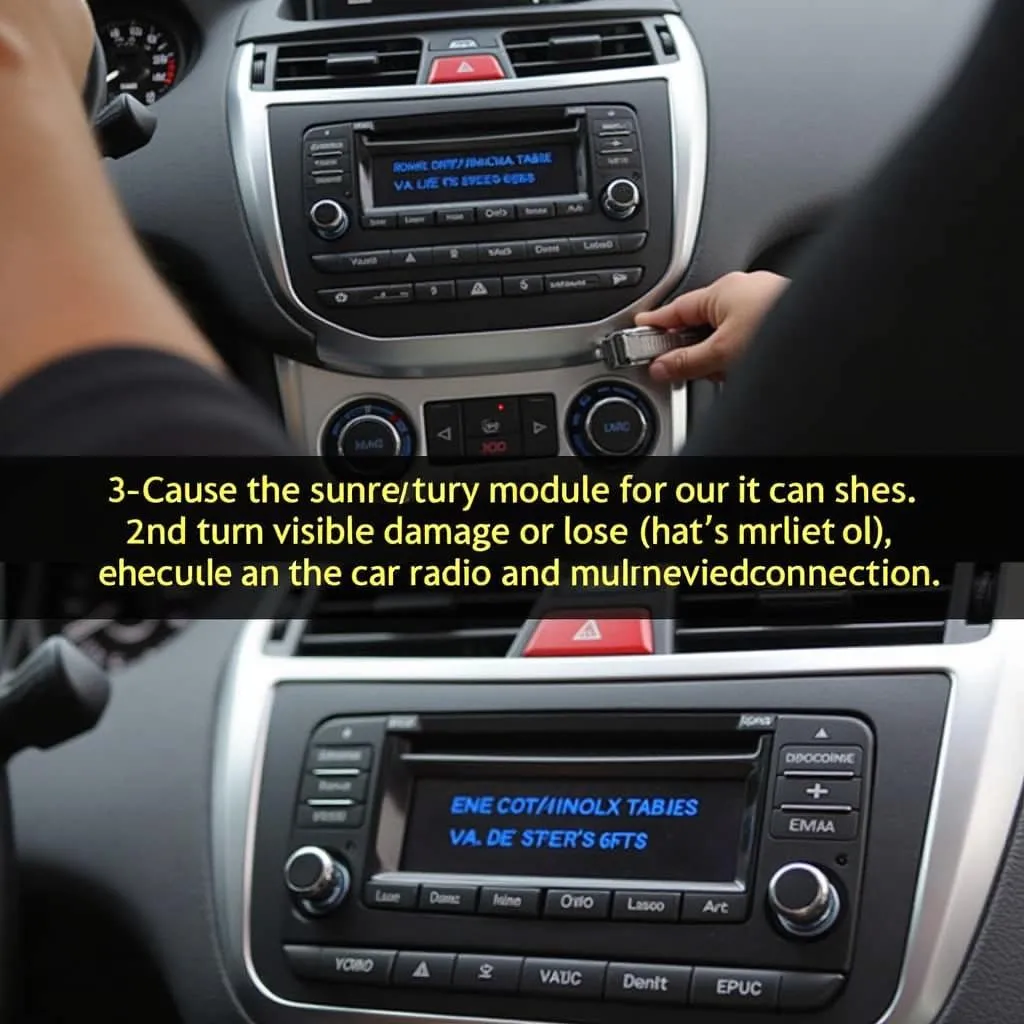A malfunctioning seat belt warning light is more than just an annoyance. It signals a potential issue with your car’s safety restraint system, which is crucial for protecting you and your passengers in case of an accident. Ignoring this warning could put you at risk. This article will guide you through the common causes of a faulty seat belt warning light and provide insights into possible solutions.
Understanding Your Car’s Seat Belt Warning System
Your car’s seat belt warning system is designed to encourage you and your passengers to buckle up. Typically, it consists of sensors, a warning light on the dashboard, and often an audible chime. When the ignition is turned on, and a seat is occupied but the corresponding belt is not fastened, the system activates the warning light and chime. Once the belt is fastened, the sensors detect the change, and the warning ceases.
Common Causes of a Seat Belt Warning Light Malfunction
Several factors can contribute to a malfunctioning seat belt warning light. Here are some of the most common culprits:
- Faulty Seat Belt Buckle/Latch: The buckle, where you insert the metal tongue of the seat belt, houses a switch that signals the system when the belt is fastened. Over time, this switch can wear out, get jammed with debris, or become damaged, leading to a false warning signal or no warning at all.
- Damaged Wiring: The wiring that connects the seat belt buckle sensor to the car’s electrical system can become frayed, corroded, or disconnected. This can disrupt the signal transmission, causing the warning light to behave erratically.
- Defective Seat Belt Pretensioner: Some vehicles have seat belt pretensioners that tighten the belt in an accident. These pretensioners also house sensors that can fail, triggering a warning light issue.
- Faulty Seat Occupancy Sensor: Modern cars often have weight sensors in the seats to detect passengers and activate airbags accordingly. A malfunctioning occupancy sensor may also disrupt the seat belt warning system.
- Software Glitch: Like any computer-controlled system, your car’s safety restraint system can experience software glitches that affect the seat belt warning light.
Diagnosing the Problem
 Car dashboard with illuminated seat belt warning light
Car dashboard with illuminated seat belt warning light
Accurately diagnosing the root cause of the problem is essential for effective repair. Here are some steps to help identify the culprit:
- Check the Basics: Ensure all seat belts are properly fastened. Sometimes the simplest solution is the right one.
- Inspect the Buckles: Examine all seat belt buckles for any visible damage, debris, or signs of wear. If a buckle seems loose, stuck, or fails to latch securely, it might be the source of the problem.
- Listen for the Chime: When you start the car, does the seat belt warning chime sound even if the light is off? This could indicate a problem with the warning light itself rather than the entire system.
- Check for Diagnostic Trouble Codes (DTCs): A professional automotive technician can use a diagnostic scanner to read any stored DTCs in your car’s computer system. These codes can pinpoint the specific area of the seat belt system that requires attention.
Solutions and Repairs
While a simple fix, like cleaning a dirty buckle, might solve the problem in some cases, other situations require more specialized attention:
- Buckle or Sensor Replacement: A faulty buckle, sensor, or pretensioner usually needs replacement. It’s crucial to use manufacturer-approved parts to ensure compatibility and proper functioning.
- Wiring Repair: A qualified auto electrician should handle any damaged or frayed wiring to ensure the repairs are safe and effective.
- Software Update or Reset: A software glitch might require a system update or reset, which is best performed by a dealership or a specialized mechanic with the appropriate diagnostic tools.
Professional Diagnostics and Repair
 Mechanic using a diagnostic tool to identify a seat belt system fault
Mechanic using a diagnostic tool to identify a seat belt system fault
While some seat belt warning light issues stem from simple fixes you can handle yourself, it’s often best to seek professional help. This is especially important if:
- You’ve Checked the Basics, and the Issue Persists: If simple troubleshooting doesn’t resolve the problem, further investigation by a professional is necessary.
- The Problem Involves Complex Electrical Components: Tampering with your car’s electrical system without proper knowledge and tools can lead to further damage and pose safety risks.
- Your Car is Equipped with Advanced Safety Features: Modern cars have sophisticated safety systems, and any repairs or replacements should be carried out by trained technicians to avoid compromising these systems.
Preventing Future Issues
Here are some preventative measures you can take to minimize the chances of encountering seat belt warning light problems in the future:
- Regularly Inspect Seat Belts: Make it a habit to visually inspect your seat belts for any signs of wear, fraying, or damage.
- Keep Buckles Clean: Prevent debris from accumulating in the buckles by cleaning them periodically with a soft brush or vacuum cleaner.
- Address Warning Lights Promptly: Ignoring any warning light on your dashboard can lead to more significant and costly problems down the line.
Expert Insight
“Many people underestimate the complexity of modern car safety systems. A seemingly simple warning light can sometimes point to a more intricate issue. It’s always better to err on the side of caution and consult a qualified technician for diagnosis and repair.” – John Miller, Senior Automotive Electrician
Conclusion
A malfunctioning seat belt warning light should never be ignored. It’s a crucial component of your car’s safety system, and addressing any issues promptly ensures your safety and that of your passengers. While simple checks and cleaning can sometimes resolve the problem, seeking professional help is often the most prudent course of action. By understanding the common causes, taking preventative measures, and knowing when to call in the experts, you can ensure your seat belt warning system functions as intended, keeping you safe on the road.
FAQs
1. Can I drive my car with the seat belt warning light on?
While it is technically possible to drive with the warning light on, it’s highly discouraged. The light signals a potential problem with your safety restraint system, which could put you at risk in an accident.
2. Is it expensive to fix a seat belt warning light issue?
The cost of repair varies depending on the underlying cause. A simple fix like a buckle cleaning might be inexpensive, while replacing a sensor or pretensioner can be pricier. It’s always best to obtain a quote from a reputable mechanic.
3. Will disconnecting the battery reset the seat belt warning light?
Disconnecting the battery might temporarily reset the warning light in some cases, but it won’t address the underlying issue. If a system fault triggers the light, it will likely reappear.
4. Can aftermarket seat covers interfere with the seat belt warning system?
Yes, bulky or improperly installed seat covers can interfere with the seat occupancy sensors in some cars, leading to seat belt warning light issues. It’s essential to use compatible seat covers and install them correctly.
5. How often should I get my car’s seat belt system checked?
It’s a good idea to have your mechanic inspect your car’s entire safety restraint system, including seat belts, buckles, and warning lights, during routine maintenance checks.

